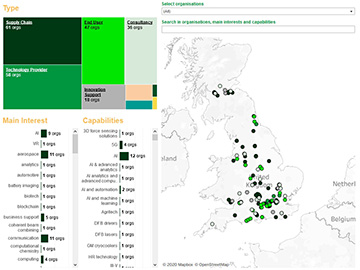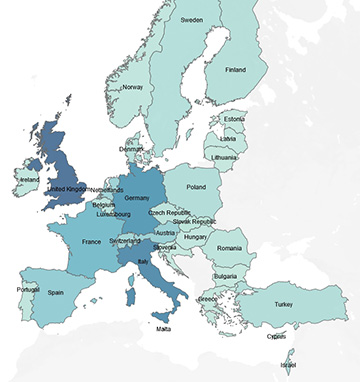
A pair of new online resources seek to map the size and distribution of quantum research groups, industry and funding in the United Kingdom and in the countries of the European Union. [Image: U.K. Quantum Landscape Map/KTN] [Enlarge image]
In the past decade, both the United Kingdom and the countries of Europe have targeted significant funding and research activity in quantum technology—and the photonics industry, with other businesses, is seizing on the opportunities that the trend could hold. But keeping track of the rapid growth of quantum funding opportunities, businesses and research priorities in various countries has been a difficult job. Recently, a pair of new online information resources has emerged that could make the task considerably easier.
The U.K. Quantum Landscape Map, a project released in early November by KTN—a U.K.-based organization focused on forging connections among academia, industry and government for technology transfer—offers a deep-dive database of industrial activity, government-funded projects, research groups and other players on the U.K. quantum scene. And the EU Quantum Sector in Europe map, a resource sponsored by the EU research consortium QuantERA (with active participation by KTN), paints a similar picture for continental Europe—both for the EU as a whole and for individual European countries.
A well-spent summer
The two landscape maps were developed during summer 2020—and, according to Najwa Sidqi, an OSA early-career member and KTN’s knowledge-transfer manager for quantum technologies, who worked on both projects, they aim at providing a clearer view of a burgeoning sector. “It’s really hard to keep up with the growth of the quantum sector, both in the U.K. and worldwide,” Sidqi told OPN in an interview earlier this year. “This is a landscape that is progressing every day at a very quick pace.”

Najwa Sidqi. [Image: KTN]
The U.K. in particular, as Sidqi points out, was an early leader in government funding of quantum tech, with its total investment thus far estimated at around £1 billion (US$1.34 billion at current exchange rates). This public effort, largely administered through the agency U.K. Research and Innovation (UKRI), pushes money to quantum research and applications through a range of councils and other channels. These include, for example, the country’s Engineering and Physical Sciences Research Council, which has funded the creation of a variety of quantum technology research hubs in metrology, information and communications; and vehicles such as a £153 million Industrial Strategy Challenge Fund.
From research to commercialization
In the most recent round of government activity, the focus of spending has conspicuously shifted from basic research on quantum technology to commercialization and industrialization of those technologies, Sidqi says. She points, for instance, to a quantum accelerator project begun this year as a partnership between the government’s Innovate UK program and the technology investment firm IP Group. The accelerator will support small companies pioneering technologies crucial to making quantum techniques commercially viable.
The recently released U.K. landscape map attempts to capture and organize this diverse government and private funding effort. It also offers a view into the industry that quantum research has spawned, listing 204 separate U.K. businesses involved in the quantum supply chain, technology consulting and other areas, along with their expertise and their capabilities. And it summarizes the 160 different quantum research groups working in the country, and national research centers and training centers focused on quantum.
Overall, KTN says it hopes that the map will “become a point of reference for quantum capabilities in the UK, allowing every user to find a suitable contact point from academia and/or industry.”
The EU’s quantum map

Image from QuantERA map of European quantum landscape. Darker-colored countries have higher numbers of quantum projects listed in the database. [Image: QuantERA Quantum Sector in Europe map]
The QuantERA-sponsored European quantum landscape map, released at the end of November, posed a different set of challenges. As a network of 32 organizations active in quantum technology in 27 countries, QuantERA wanted to capture both the funding scene at the EU level—including projects such as the much-heralded, 10-year, €1 billion EU Quantum Flagship—and the country-level funding that, in the aggregate, accounts for a much greater sum.
On that head, the QuantERA map identifies, in 35 European countries (including non-EU members such as the United Kingdom, Norway and Switzerland), 121 research funding organizations; 108 quantum companies; 39 EU-specific public databases to tap for information on quantum technology; 717 separate research activities in different countries; and scores of EU-funded projects and community contacts in quantum.
Mission-driven qubits
What will all of this ferment in quantum technology ultimately yield? To Sidqi—looking particularly from the viewpoint of the U.K.—it’s all about taking the performance of science and technology in the diverse areas touched by quantum tech to new levels.
“The U.K. is looking at this from the perspective of revolutionizing different areas,” Sidqi says. “These are things like secure communications and networks; health care sectors, like brain imaging; and high-performance computing systems … It’s a way to up the performances in different sectors.”
She stresses, for example, the prospects for quantum technology to make a difference in the speed of data-intensive AI and deep-learning computing that can drive new discoveries in materials science and pharmaceuticals. “That’s very much the focus of the current global situation,” she observes, in a world beset by COVID-19.
Sidqi also sees a role for quantum technology in tackling other “grand challenges” that, both in the U.K. and the EU, have become an increasing focus of funding. In the area of climate change, for example, she notes possible applications in the country’s “net-zero” decarbonization drive and in addressing threats to biodiversity. These are areas, she says, where “quantum has a big potential to help, in the U.K. and worldwide, for improving performance in computing, and in imaging and sensing.”
